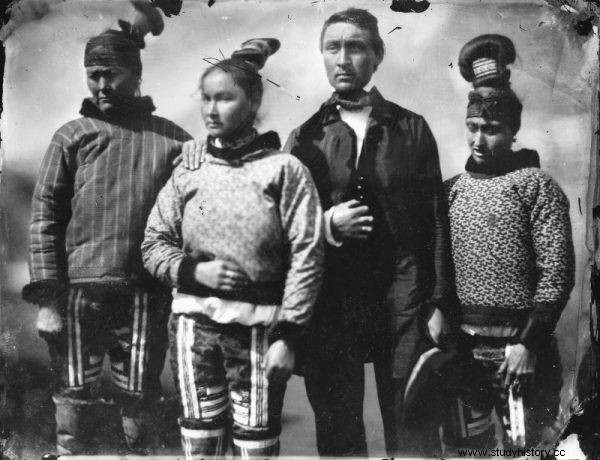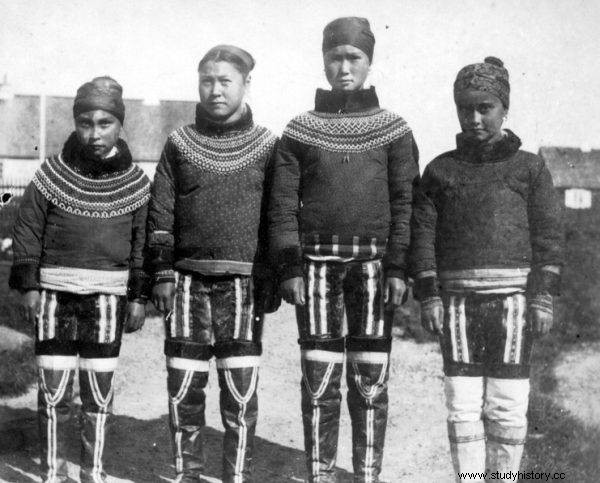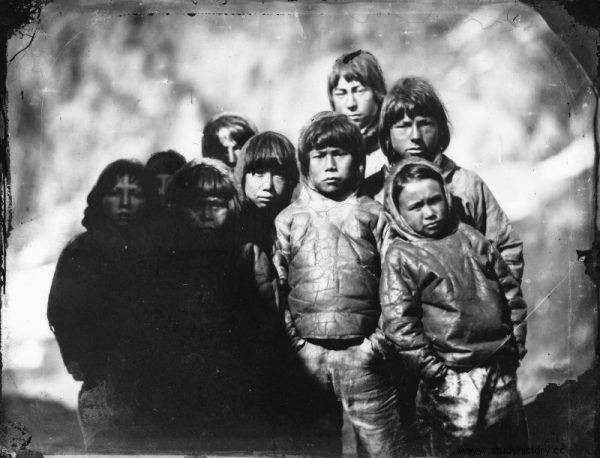In the 1950s, the Danes conducted a social experiment. Their goal was to create a new generation of Greenlanders. Instead, they led to a tragedy.
The Inuit are indigenous peoples of the north living in the harsh conditions of the arctic and sub-arctic areas of Greenland, Canada, Alaska and Siberia. They come from Asia, and came to North America about 4,500 years ago, after crossing the Bering Strait. Living in these areas has influenced both their physical appearance as well as their customs, culture and daily activities. A stocky body structure, flat noses and a larger and more efficient liver made it easier for them to survive in hostile conditions.
They earned their living mainly from hunting, as the tundra climate was not conducive to farming. They hunted for seals, walruses, narwhals, tundra reindeer and white bears. The game not only provided them with food, but also fur, leather and bones needed for sewing clothes, building boats, tools and household furnishings. Nothing could be wasted here. Almost 100% of each catch was used.
Greenland at issue
With the colonization of North America, the Inuit territories began to change hands, and their new owners more or less influenced the culture and population of local peoples.

The experiment was to send local children to Denmark, where they would get to know the country's culture, learn the Danish language and modern lifestyle (illustrative photo)
An example of this is the history of Greenland. An island whose land many argued about, but few cared about the local people. By both Europeans and Americans, the Inuit peoples were considered primitive communities that needed to be converted and made aware how much better their lives would have been if they had conformed to the invaders' standards. This thinking led not only to the destruction of local cultures, but most of all human tragedies. And the most recent one took place in the second half of the 20th century.
Danish Paradise
In 1951, an experiment was launched to improve the fate of the Inuit living in Greenland. The island was owned by Denmark at the time, but local residents felt little sense of belonging to this developing country. For the Inuit, the Danes were the invaders who considered them a backward society , who speak the local language and live from hunting. However, the time has come to change that.
Danish officials began wandering in remote Inuit lands and urging residents to take part in an unusual experiment. It was supposed to consist of sending local children to Denmark, where they would get to know the country's culture, learn Danish and modern lifestyle . Everything was supposed to last 6 months and contribute to the upbringing of a new generation of Greenlanders.
Many parents refused to allow their children to participate in the experiment. However, some of them bowed, lured by the vision of a Danish paradise and put under pressure from officials. In May 1951, 22 children between the ages of 6 and 10 set off on a journey to a country some of them had not even heard of before.
Children's hell
Terrified and wanting to return to their parents, the little ones reached Copenhagen, where they were first subjected to isolation. They were taken to the so-called summer camp. It was an isolated place where they had been quarantined. It was feared that they might have brought infectious diseases with them. At the end of isolation, the camp was visited by Danish Queen Ingrid herself, expressing her approval of the project.

Inuit children suffered a great deal of trauma (photo demonstration)
Then the children were placed among foster families with whom they spent not the promised 6, but as much as 12 months. During them a lot of emphasis was placed on education and language learning. The Danish press wrote about the progress made by the little participants in the experiment, announcing the great success. Unfortunately, the truth was quite different.
Inuit children were greatly traumatized . They felt alienated, missed their families, and were confused by the new environment and the people around them. Nobody was interested in their mental health. After a year, the decision was made to return 16 children to Greenland. 6 were left in the country permanently. Those that were sent back, however, did not return to their families. They were placed in an orphanage founded by the Red Cross in Nuuk, the capital of Greenland. This was to prevent them from returning to the worse conditions that awaited them at home.
The children were also forbidden to use an indigenous language. They were to continue their education to get a better education and to act as an impulse for the development of Danish culture in Greenland. However, that did not happen.
Failed experiment
The result of the experiment was not the creation of a new and better generation, but a human tragedy. The children struggled emotionally and mentally for the rest of their lives . Many of them had difficulties in establishing relationships as well as rebuilding family ties. They struggled with alienation and social exclusion. Some of them became alcoholic. Much left this world too soon.

The result of the experiment was not the creation of a new and better generation, but a human tragedy. The children struggled with problems for the rest of their lives (illustrative photo).
The experiment also worsened Danish-Greenlandic relations, becoming one of the driving forces behind the drive of local residents to create autonomy. This was finally done in 1979.
Some of the people responsible for carrying out the experiment tried to hide the truth about its course and results, but the memory of these events has survived. In 2010, the Greenlandic authorities demanded an official apology from the Danish government which were finally submitted by the prime minister in 2020. They were also joined by organizations that took part in the project - the Red Cross and Save the Children Denmark. Currently, the last six of the "experimental" children have filed a lawsuit. They are claiming damages from Denmark amounting to $ 37,800 for each of them.
Bibliography
- Ellen Otzen, The children taken from home for a social experiment , bbc.com, 10/06/2015 (accessed:11/12/2021).
- Denmark. Indigenous Greenlanders are demanding compensation from the state for a failed experiment , polsatnews.pl, 23/11/2021 (accessed:11/12/2021).
- A social experiment that turned into a human drama , wp.pl, 12/06/2015 (accessed:11/12/2021).
- Inuit. A northern people who have learned to cope with extreme conditions , onet.pl, 27/06/2020 (access:11/12/2021).
